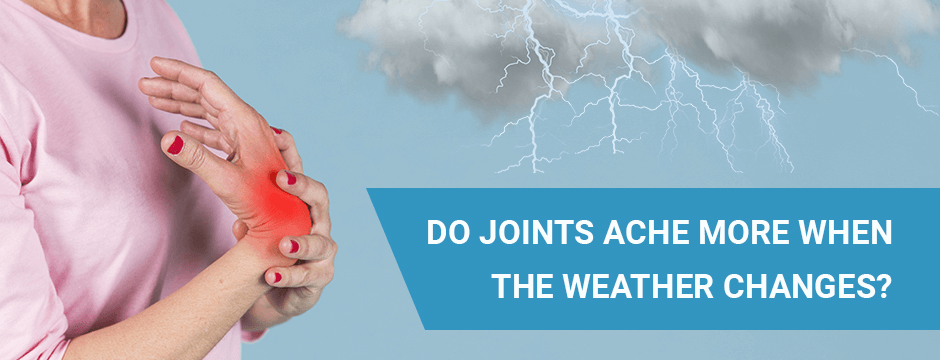
Older adults and people with past injuries often complain of stiff achy joints, and many swear they can predict the weather, based on their degree of joint discomfort. This is an ages-old phenomenon that has only recently drawn serious attention from the health community. While research is scarce on the topic, there is a handful of recent studies that shed light on the relationship between weather changes and joint pain.
Most people whose joints tell them the weather is about to change find a correlation between specific weather conditions and joint flare-ups. The most commonly reported episodes involve cold weather and joint pain, and barometric pressure also appears to play a role.

The most common conditions that affect joint pain are:
Find our more about sacroiliac joint pain here

There are multiple conditions that can cause chronic joint pain, and many can be treated and resolved with physical therapy:
When joints are already stiff and achy, changes in the weather may make them feel worse. People have associated increased joint pain with weather changes for centuries, and the medical research community is finally listening.
The body of research on weather and joint pain is sparse, but a few recent studies have attempted to establish a link, with varying results.
Just because there is not a wealth of research to strongly support a link between weather and pain, it does not mean a relationship does not exist. Pain is perceptual, and only you know what your joints are telling you, and under what circumstances your pain flares up. At the end of the day, if you think you hurt more, you are right.

There are a few things you can do to protect your joints during weather changes to make them less achy:
If you suffer from chronic joint pain, physical therapy can help. At NYDNRehab, we use advanced technologies and innovative treatment methods to identify the source of pain and eliminate it.
Our high-tech toolbox includes:
In addition to our high-tech equipment, we use manual therapies, shock wave therapy and injection therapies to restore pain-free joint function and optimize joint range of motion, so you can enjoy the best quality of life. Don’t wait for the weather to change to get pain relief for your achy joints. Contact the joint pain specialists at NYDNR today.
Resources:
CDixon, William G., et al. “How the weather affects the pain of citizen scientists using a smartphone app.” NPJ digital medicine 2.1 (2019): 1-9.
Jena, Anupam B., et al. “Association between rainfall and diagnoses of joint or back pain: retrospective claims analysis.” bmj 359 (2017).
McAlindon, Tim, et al. “Changes in barometric pressure and ambient temperature influence osteoarthritis pain.” The American journal of medicine 120.5 (2007): 429-434.
Steffens, Daniel, et al. “Effect of Weather on Back Pain: Results From a Case‐Crossover Study.” Arthritis care & research 66.12 (2014): 1867-1872.
Timmermans, Erik J., et al. “The influence of weather conditions on joint pain in older people with osteoarthritis: results from the European Project on OSteoArthritis.” The Journal of rheumatology 42.10 (2015): 1885-1892.
Dr. Lev Kalika is a world-recognized expert in musculoskeletal medicine. with 20+ years of clinical experience in diagnostic musculoskeletal ultrasonography, rehabilitative sports medicine and conservative orthopedics. In addition to operating his clinical practice in Manhattan, he regularly publishes peer-reviewed research on ultrasound-guided therapies and procedures. He serves as a peer reviewer for Springer Nature.
Dr. Kalika is an esteemed member of multiple professional organizations, including: